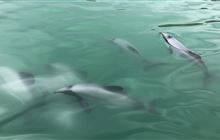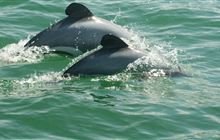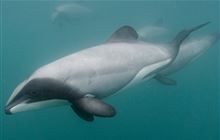You can help Hector’s and Māui dolphins
Introduction
There are many ways you can help these dolphins, from reporting sightings around the coast to putting cat faeces in the bin, not the toilet.On this page:
- Tell us if you see a dolphin
- Call us if you catch or harm a dolphin
- Dispose of cat faeces in the bin
- Use set-nets safely
- Act safely on the water around dolphins
Tell us if you see a dolphin
Report stranded, injured or entangled dolphins
If you see a dolphin in distress call DOC's emergency hotline immediately 0800 DOC HOT (0800 362 468) and follow any instructions from our staff.
Fast reporting makes it more likely that we can save dolphins that are stranded, injured or tangled in a rope or net.
Report dead dolphins
Sometimes dead dolphins are found washed up on a beach. Fast reporting is important. We can gather much more information from a fresh carcass than one where decomposition is well underway.
We can get valuable information about Hector’s and Māui dolphins from a necropsy of a dead dolphin. This includes scientific data, including genetic information, which may help manage the threats dolphins face. Necropsy is the dissection of a carcass to find out why the animal died.
Report sightings of live dolphins
Sightings of Hector’s and Māui dolphins around the coast of the North Island provide important information for understanding and protecting these dolphins.
Call us if you catch or harm a dolphin
Call our emergency hotline 0800 DOCHOT (0800 362 468) immediately if you accidentally catch, harm or kill a dolphin. It’s not illegal to accidentally catch a dolphin, but you must report it as soon as possible.
If the dolphin is alive, release it back into the water as quickly and gently as possible, as long as it is safe for you to do so. If the dolphin is dead, bring it to shore if you can – particularly if you have caught a Hector's or Māui dolphin. We will provide instructions about what to do when you get there.
If you can’t bring the dead dolphin to shore, take photos and release the carcass at sea.
Dispose of cat faeces in the bin
Cat faeces are a source of the disease toxoplasmosis, which is caused by a parasite. Toxoplasmosis is a known cause of death in Hector’s and Māui dolphins and is likely to be a significant human-caused threat to their populations.
Keep dolphins safe from toxoplasmosis.
Use set-nets safely
Follow the rules about where you can and can’t use a set-net around the coast.
Always stay with your set-net and take it out of the water immediately if you see a dolphin nearby. If you see set-nets being used in areas that are closed for netting contact the Ministry for Primary Industries.
Act safely on the water around dolphins
Seeing dolphins in the water is a very special experience. Following these rules will help keep them safe:
- Manoeuvre your boat carefully and approach dolphins carefully from the side and slightly behind a group. Do not obstruct their path, cut through a group or separate mothers from calves.
- Avoid loud or sudden noises – these can startle dolphins.
- Don't swim with dolphins if there are calves present and don't try to touch or feed dolphins.
- Don't approach a group of dolphins if three or more boats are already within 300 m of the group. Cooperate with others so everyone gets a view without disturbing or putting the dolphins at risk.



